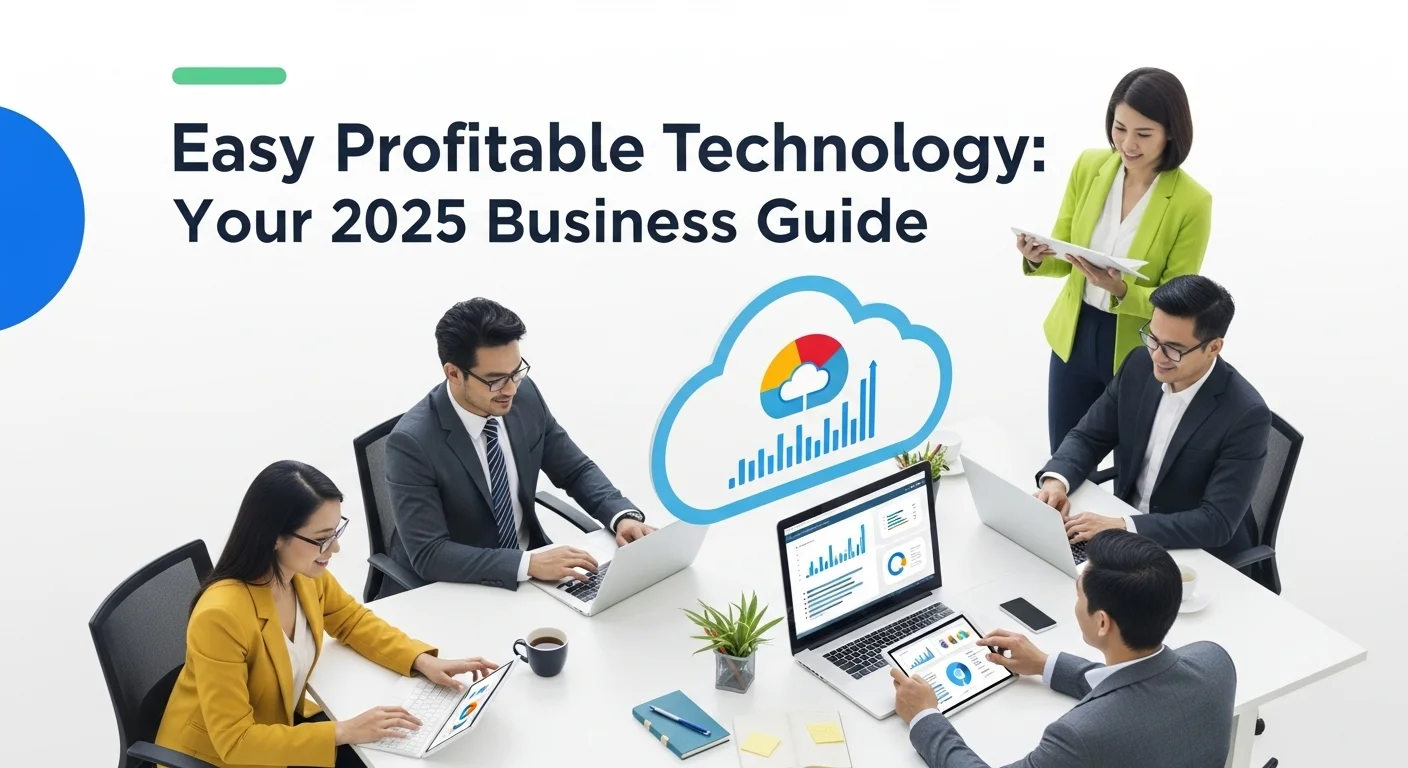How to Launch a Profitable Tech Business in 2025 (Without a Huge Budget)

Executive Summary
Let's be honest, the phrase 'easy profitable business' often sounds like a late-night infomercial promise. But after years of mentoring startups and building my own ventures, I've seen a massive shift. Thanks to incredible new technologies, starting a successful business is no longer just for those with deep pockets or a computer science degree. This guide is my personal roadmap for you. We'll first redefine what 'easy and profitable' truly means in 2025—it's not about zero effort, but about smart leverage. Then, I'll walk you through specific, high-demand business ideas in AI, cybersecurity, and specialized software that you can start today. Finally, I’ll share my go-to strategies and tools for building a sustainable business that doesn't just launch, but thrives. This is about turning your great idea into a real, profitable venture using the amazing tools at our fingertips.
Table of Contents
Table of Contents
- What's a 'Low-Cost, High-Impact' Tech Business Anyway?
- Your Roadmap to Launching a Profitable Tech Venture
- Tips and Strategies to Grow and Sustain Your Business
What's a 'Low-Cost, High-Impact' Tech Business Anyway?
When I first started in tech, launching a business meant one thing: raising a ton of money. You needed it for servers, for software licenses, for a team of expensive developers. The barrier to entry was a massive wall of cash. Today, that wall has crumbled. The idea of a low-cost, high-impact business isn't a fantasy; it's the new reality. It’s a business model built on leveraging powerful, accessible technology to keep startup costs low while maximizing your potential for growth and profit. It's about working smarter, not just harder. For anyone looking to start a business today, understanding this shift is the single most important step. It’s the difference between dreaming and doing.
So what made this possible? I've seen it firsthand, and it comes down to a few key pillars. First, the cloud. I'm talking about services like Amazon Web Services (AWS) or Google Cloud. They completely changed the game. Instead of buying a room full of blinking machines, you can now 'rent' world-class computing power and pay only for what you use. This turned a huge upfront capital cost into a small, manageable operating expense. This alone democratized the ability to launch software businesses. The second pillar is the Software-as-a-Service (SaaS) explosion. Why build a payment system from scratch when you can plug in Stripe? Why develop your own customer database when HubSpot or Salesforce exists? We live in a world of building blocks, allowing founders to assemble sophisticated operations with incredible speed.
Then came the real game-changer, especially for non-technical folks: No-Code and Low-Code platforms. Tools like Bubble, Webflow, and Zapier are revolutionary. They give you the power to build custom applications, automate complex workflows, and design beautiful websites without needing to be a coding wizard. I’ve seen founders with a great idea build a fully functional prototype over a weekend, show it to potential customers, and get real feedback. This ability to test, learn, and adapt without sinking a fortune into development is the heart of a lean, modern startup. It dramatically lowers the risk and puts the focus back where it belongs: on solving a real problem for your customers.
And now, we're in the age of accessible Artificial Intelligence (AI). What used to be the exclusive playground of tech giants is now available to everyone through APIs from companies like OpenAI. You can now build AI-powered features directly into your services—from intelligent chatbots that transform customer service to tools that write marketing copy or analyze market data. You could start a service that creates personalized meal plans using AI or a tool that helps small law firms summarize legal documents. These are highly scalable businesses that can often be run by one or two people, the very definition of a low-cost, high-impact venture.
The applications are everywhere. A freelance designer can use AI to generate mood boards in seconds. An e-commerce entrepreneur can use a platform like Shopify, connect it to a dropshipping supplier so they hold no inventory, and use AI tools to run their marketing campaigns. This is a classic model where the focus isn't on manufacturing or logistics, but on building a brand and connecting with customers. In consulting, an expert in any field can now serve a global clientele. A cybersecurity specialist can remotely assess the vulnerabilities of a small business that could never afford a full-time security chief. This is about leveraging your expertise, not your capital.
The benefits are huge. For you, the entrepreneur, it means less risk, a faster launch, and the freedom to build a business from anywhere. For the economy, it fuels innovation and competition, leading to better products for everyone. But for me, the most exciting part is the democratization of opportunity. Your success is no longer dictated by your bank account or your degree, but by the quality of your idea and your ability to execute it with the incredible tools now available. The journey to launching a profitable business has never been more accessible.

Your Roadmap to Launching a Profitable Tech Venture
Having a great idea is one thing, but turning it into a real, money-making business requires a plan. This is my guide to help you navigate that journey. It's about making smart choices with technology and business strategy to build a lean, efficient, and scalable operation. The whole principle is to use existing platforms to do the heavy lifting, so you can focus your energy on what truly matters: creating value for your customers. Whether you're drawn to AI, cybersecurity, or software, there's a clear path to building a successful venture.
Finding Your Niche: Business Models That Work
My first piece of advice to any founder is this: don't try to boil the ocean. The quickest way to fail is to build a generic product for everyone. The path to profitability is in finding a specific, underserved niche and becoming the absolute best solution for them. Here are a few areas I've seen explode with opportunity:
1. AI-Powered Consulting and Services: Every business wants to use AI, but most have no idea where to start. This gap is your opportunity. You become the expert guide.
- The Idea: AI Chatbot Implementation. You offer to build, train, and manage custom chatbots for local businesses (think dentists, real estate agents, restaurants) to handle appointments and answer common questions.
- How You Do It: You don't build the AI yourself. You master a platform like Tidio, Dialogflow, or ManyChat. Your value is in understanding the client's business, designing a great conversational experience, and providing ongoing support. This is a fantastic high-margin service business.
- Another Idea: AI-Powered Marketing for Small Shops. Offer packages that include AI-generated social media content, email newsletters, and ad copy using tools like Jasper or Copy.ai. You provide sophisticated marketing services they could never afford from a big agency.
2. Specialized Cybersecurity for Small Businesses: Small and medium-sized businesses are prime targets for cyberattacks because they often lack defenses. Offering affordable, easy-to-understand security services is incredibly valuable.
- The Idea: Phishing Simulation and Training as a Service. You run controlled phishing campaigns on a company's employees and provide simple online training to those who get tricked. It's a recurring revenue service that provides immense value.
- How You Do It: Use a platform like KnowBe4 or the open-source GoPhish. Your job is to manage the campaigns and deliver clear, actionable reports to management, helping them build a more secure culture.
- Another Idea: 'Security Health Check' Service. Offer a one-time service where you use tools like Nessus Essentials to scan a company's website for common vulnerabilities and provide a simple report with recommendations.
3. Niche Software-as-a-Service (SaaS) with No-Code: Recurring revenue from a SaaS product is a beautiful thing. No-code platforms have made this dream accessible to everyone.
- The Idea: Build a simple project management tool for a specific niche you understand well—like landscape gardeners or freelance writers. Generic tools like Asana are often too complex; you can win by being simple and perfectly tailored.
- How You Do It: Use a platform like Bubble.io to build the web app without code. Integrate with Stripe for payments and other APIs as needed. The key is to obsessively focus on the unique workflow of your target customer and solve their problems better than anyone else.
Smart Business Techniques for a Lean Operation
The tech is only half the battle. Your business habits will determine your success.
- Launch an MVP (Minimum Viable Product): Don't vanish for a year to build the 'perfect' product. Build the simplest possible version that solves one core problem and get it in front of customers. Their feedback is worth more than any business plan.
- Master One Marketing Channel: Don't try to be on TikTok, LinkedIn, Facebook, and X all at once. Find the one place where your customers hang out and dominate it. Become a valued voice in that single community first.
- Automate Ruthlessly: Use tools like Zapier or Make.com to connect your apps and eliminate repetitive tasks. Automate your invoicing, social media posts, new client welcome emails—everything you can. Every hour you save is an hour you can spend growing the business.
- Productize Your Service: Instead of selling hours, sell packages. For example, a 'Website Security Starter Pack' or a 'Monthly AI Content Plan'. This makes your services easier to sell and your revenue more predictable.
Choosing the Right Tools for the Job
Your tech stack is your foundation. Here's a quick cheat sheet:
- For Your Website/App Host:
- Shared Hosting (e.g., Bluehost): Cheap and easy. Best for a simple blog or marketing site.
- VPS (e.g., DigitalOcean): More power and control. Good for when your web app starts getting real traffic.
- PaaS (e.g., Heroku, Render): Super easy to deploy and scale. My pick for founders who want to move fast and not worry about servers.
- For No-Code Building:
- Bubble.io: The powerhouse. It has a learning curve, but you can build almost any complex web app with it.
- Webflow: The king of visually stunning websites. Perfect for marketing sites, agencies, and high-end e-commerce.
- Glide / Adalo: The go-to for building simple mobile apps quickly.
By picking a niche, mastering a few powerful tools, and running a lean operation, the path to a profitable tech business becomes incredibly clear. It's about being strategic, focused, and leveraging the amazing technology that's right at your fingertips.

Tips and Strategies to Grow and Sustain Your Business
Getting your tech business off the ground is an amazing feeling, but that's where the real work begins. To build something that lasts, you need to focus on sustainable growth and smart habits. Over the years, I've seen what separates the businesses that thrive from those that fizzle out. This section is all about the practical, actionable advice I give to founders to help them build a resilient and truly profitable venture for the long haul.
Best Practices for Long-Term Success
1. Become the Biggest Fish in a Small Pond: I can't stress this enough. We touched on finding a niche, but now you need to obsess over it. Become the undisputed expert in that small world. Join their online communities, listen to their podcasts, and learn their language. Your deep understanding of their unique struggles will become your most powerful asset, guiding everything from your marketing messages to your product features.
2. Build Your Personal Brand: In a world of faceless software, people want to connect with people. Building your own personal brand builds trust and makes you an authority. You don't have to be a superstar influencer. Just pick one platform—LinkedIn is fantastic for B2B, Instagram or YouTube for more visual work—and start sharing what you know. Write articles, record short videos, or answer questions in forums. Give away valuable advice for free. This positions you as the expert, so when people are ready to buy, they think of you first.
3. Treat Customer Feedback Like Gold: Your first version will be flawed. That's okay. The key to success is to create a tight feedback loop with your early customers and iterate relentlessly. Make it easy for them to talk to you—use simple surveys, schedule quick calls, or create a Slack channel. Listen to their frustrations and their ideas. This feedback is your roadmap to building a product people love and can't live without. A business that listens is a business that grows.
4. Be a Perpetual Student: Technology moves at lightning speed. The tool that is revolutionary today could be irrelevant in two years. You have to stay curious. I dedicate a few hours every single week to learning. I subscribe to newsletters like TechCrunch and Stratechery, listen to tech podcasts on my commute, and experiment with new tools. This not only helps you improve what you're already doing but also reveals the next big opportunity on the horizon.
My Go-To Tools for Business and Technology
The right tools don't just save you time; they create a calm, organized system that lets you focus on what's important. This is a look inside my personal toolkit—the things I recommend to every founder I mentor.
- For Organizing Your Brain and Projects:
- Trello: The simplest way to visualize your workflow. It's a digital whiteboard with sticky notes. Perfect for solo founders and small teams.
- Notion: My business's central nervous system. It's a flexible space for notes, tasks, company wikis, and databases. It's whatever you need it to be.
- For Marketing and Making Sales:
- HubSpot: Start with their free CRM. It's incredibly powerful for keeping track of your leads and customers. Their marketing tools are also top-notch.
- Zapier: I call this the magic glue of the internet. It connects all your different apps so they can talk to each other. For example: when a customer pays you on Stripe, Zapier can automatically add them to your email list and create a welcome task for you in Trello. It's a lifesaver.
- For Getting Paid and Managing Money:
- Stripe: This is the gold standard for accepting payments online. It's secure, reliable, and easy to set up. Don't use anything else.
- Wave: For freelancers and small businesses, Wave offers free accounting and invoicing software that is simple to use and perfect for tracking your finances from day one.
A Resource for a Deeper Dive
If you're looking for a more structured checklist on the mechanics of launching, I often recommend the Forbes Tech Council's guide on launching a tech startup. It's a great companion to the strategies we've discussed, offering a solid perspective on things like market research and legal steps.
My Final Thoughts on Your Tech Journey
Building a profitable tech business today is about creating a smart, adaptable system. It's a system of well-chosen tools, efficient processes, and personal habits that allow you to deliver incredible value without needing a huge team or a mountain of cash. Embrace automation, stay curious, and listen obsessively to your customers. The power of modern technology has leveled the playing field, allowing a single person with a great idea to build a global business. The path won't always be easy, but the opportunity has never been greater. Now go build something amazing.
Expert Reviews & Testimonials
Sarah Johnson, Small Business Owner ⭐⭐⭐⭐
This guide was a real eye-opener. I run a small business and the idea of 'tech' always felt out of reach. The practical examples for AI-powered marketing and cybersecurity for SMEs are things I can actually look into. A lot less jargon than other articles.
Mike Chen, IT Consultant ⭐⭐⭐⭐⭐
As an IT consultant, I appreciate how this article breaks down complex topics. I'm often trying to explain the value of SaaS and cloud solutions to clients, and this guide frames it perfectly from a business owner's perspective. It's a great resource to share.
Emma Davis, Tech Founder ⭐⭐⭐⭐⭐
Finally, an article that gets it! The author's personal experience shines through. It's not about 'get rich quick' schemes, but about smart, strategic ways to leverage modern tech. The section on building a personal brand alongside your tech stack is golden advice. Excellent read.



